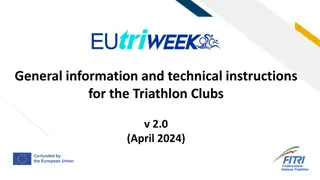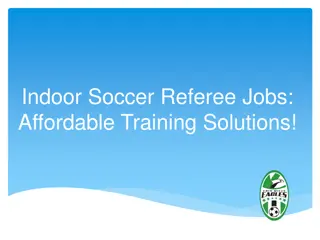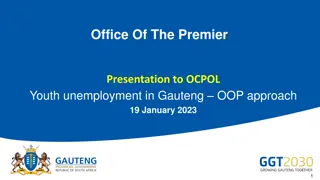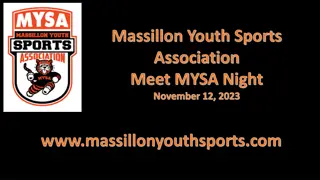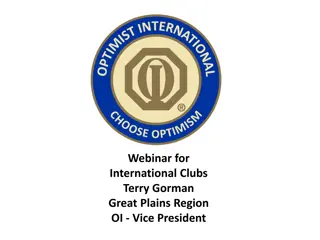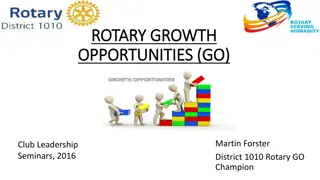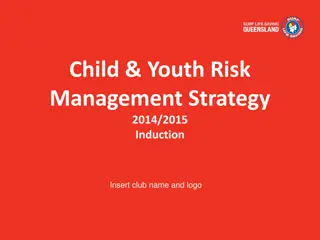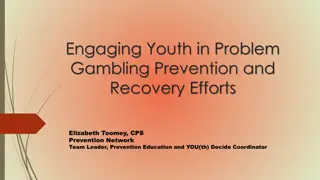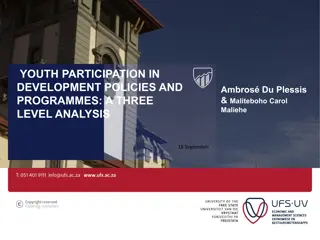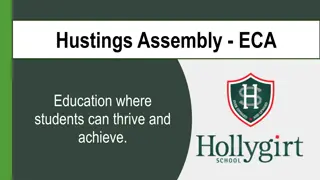Understanding the Importance of 4-H Natural Resource Clubs for Youth Development
Exploring the significance of 4-H Natural Resource Clubs through insights from surveys conducted among 4-H members, Extension Educators, and Natural Resource Professionals. The data highlights motivations, barriers, and suggested resources to enhance participation in natural resource projects, emphasizing the role of knowledgeable volunteers and valuable educational materials.
Download Presentation

Please find below an Image/Link to download the presentation.
The content on the website is provided AS IS for your information and personal use only. It may not be sold, licensed, or shared on other websites without obtaining consent from the author. Download presentation by click this link. If you encounter any issues during the download, it is possible that the publisher has removed the file from their server.
E N D
Presentation Transcript
4-H Natural Resource Club Why? What? Where? When?
4-H Natural Resource Clubs Why a 4-H Natural Resource Club? What resources are available? How do I run the club?
Why have a Natural Resource Club? 2010 Survey by Extension Educator Julia Miller Participants: 4-H members in grades 9-12 who participated in Forestry, Soil & Water Conservation, Weather, or Wildlife projects for at least three years Purdue Extension County-based staff Natural Resource Professionals
Note! 37% of youth participating in 4-H natural resource projects hope to have a career related to the area of 4-H project work Responses Youth Question What motivates you to continue to participate in one of these projects? Enjoyment/interest, 59% Family member, 10% Pursuing a career in a related field, 7% Question What are the barriers to participation? Low interest by other youth, 32.0% Lack of a knowledgeable volunteer, 22.0 % Lack of information, 21.3% n = 69
Responses Extension Educators (Youth & ANR) Barriers to participation: Low interest by youth, 39.2% Lack of a knowledgeable volunteer, 24.5% Challenges faced when identifying volunteers to help with natural resource projects Time required by volunteer, 39.8% Lack of project experts, 26.3% Difficulty finding people willing to work with youth, 20.5% Comfort level in asking volunteers to help with the NR projects: None, 14% Somewhat, 62% Very, 24% n = 105
Responses Natural Resource Professionals What resources could 4-H use to increase participation? Natural resource organizations and associations (SWCD, IDNR, NRCS, and others), 37.7% Natural resource literature Historical Maps; Indiana Community Tree Selection Guide; Field Guides; Native Trees of Indiana; 50 Trees of Indiana; lists of forests, nature centers, and wildlife preserves, tools and equipment for activities; storm water Enviroscape module; Informative brochures from various agencies (ex. DNR brochures), 14.4% 106 respondents: SWCD (59%), IDNR (34%), Weather Service (2%), Foresters (2%), Other (4%)
Suggestions from Natural Resource Professionals It may be beneficial to have a project leader for the natural resource projects. Natural resource clubs would benefit the kids, they can learn about NR, be outdoors, and perhaps this could get more children out of doors and involved with caring for their NR for the future. Involve the students about the importance of water quality and conservation, as hands on.... field trips, workshops, etc. Organize a job shadow day or field day with IDNR Actual visits to forest Work with SWCD's, DNR-Forestry, DNR-Fish & Wildlife to promote the projects in each county. Focus group discussion: Wish to be invited speakers but not to run a club
Earthcare 4-H Club, Elkhart County Leader: Janeen Bertsche-Johnson What is the Earthcare club? I started the Earthcare 4-H Club to integrate environmental education with the 4-H program. Our club does not have traditional meetings, but does hands-on activities to increase the youth participants' knowledge of forestry, soil and water conservation, wildlife, recycling, and weather. We are also intentional about doing activities that benefit our community and the environment. The club had 8 members in its first year, and has grown to 25 participants. We welcome parents and younger siblings to join our activities, so that the older youth learn leadership. See page 8 for a list of activities Janeen did with the club
What is in the NR Club Resource Kit? Soil & Water Science Beekeeping Sportfishing Entomology Weather & Climate Science Forestry Wildlife Science Geology
What are the NR Club Kits? Geared at the Level 1 age group grades 3-5 Goals: To introduce more youth to the 4-H natural resource Provide adult volunteers with resources for the club Increase natural resource project participation and knowledge
What is in the Natural Resource Kit? An introduction to the NR club and curriculum Subject matter folders Invited speaker suggestions Resources and other opportunities in 4-H Selected activities and answers or facilitation help The same information is in your spiral notebook and online at http://www.ydae.purdue.edu/NR,Club/Indiana,4-H,NR,Club.html
How Can I Use the NR Club Kit? Topic introduction how you wish: 1 topic each year 2-3 topics All 8 topics Utilize Junior Leaders and/or older youth who participate in these projects to teach/mentor Outdoor activities walks, talks, visit woods, streams, wetlands, and other areas of local interest Timing: It s up to you
Explore: Plan a NR Club Meeting Include: Target 4-H member age(s) Meeting length Materials needed When and where Agenda Topic/topics Activity/activities (from the NR club kit; review and describe) Invited speaker Reflections (experiential learning) Application Sources for more information on the topic(s)
Any Questions? Thank you for your interest and attention!
Natural Resource Club Blog for Indiana 4-H Volunteers DOCUMENT TITLE Marie Laudeman Purdue YDAE Master s Degree Student







